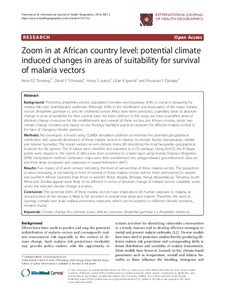| dc.contributor.author | Tonnang, H.E.Z. |
| dc.contributor.author | Tchouassi, D. |
| dc.contributor.author | Juarez, H. |
| dc.contributor.author | Igweta, L. |
| dc.contributor.author | Djouaka, R.F. |
| dc.date.accessioned | 2019-12-04T11:03:23Z |
| dc.date.available | 2019-12-04T11:03:23Z |
| dc.date.issued | 2014 |
| dc.identifier.citation | Tonnang, H., Tchouassi, D., Juarez, H., Igweta, L.K. & Djouaka, R.F. (2014). Zoom in at African country level: potential climate induced changes in areas of suitability for survival of malaria vectors. International Journal of Health Geographics, 13(1), 1. |
| dc.identifier.issn | 1476-072X |
| dc.identifier.uri | https://hdl.handle.net/20.500.12478/1037 |
| dc.description.abstract | Background: Predicting anopheles vectors’ population densities and boundary shifts is crucial in preparing formalaria risks and unanticipated outbreaks. Although shifts in the distribution and boundaries of the major malariavectors (Anopheles gambiae s.s. and An. arabiensis) across Africa have been predicted, quantified areas of absolutechange in zone of suitability for their survival have not been defined. In this study, we have quantified areas ofabsolute change conducive for the establishment and survival of these vectors, per African country, under twoclimate change scenarios and based on our findings, highlight practical measures for effective malaria control inthe face of changing climatic patterns.
Methods: We developed a model using CLIMEX simulation platform to estimate the potential geographicaldistribution and seasonal abundance of these malaria vectors in relation to climatic factors (temperature, rainfalland relative humidity). The model yielded an eco-climatic index (EI) describing the total favourable geographicallocations for the species. The EI values were classified and exported to a GIS package. Using ArcGIS, the EI shapepoints were clipped to the extent of Africa and then converted to a raster layer using Inverse Distance Weighted(IDW) interpolation method. Generated maps were then transformed into polygon-based geo-referenced data setand their areas computed and expressed in square kilometers (km2).
Results: Five classes of EI were derived indicating the level of survivorship of these malaria vectors. The proportionof areas increasing or decreasing in level of survival of these malaria vectors will be more pronounced in easternand southern African countries than those in western Africa. Angola, Ethiopia, Kenya, Mozambique, Tanzania, SouthAfrica and Zambia appear most likely to be affected in terms of absolute change of malaria vectors suitability zonesunder the selected climate change scenarios
Conclusion: The potential shifts of these malaria vectors have implications for human exposure to malaria, asrecrudescence of the disease is likely to be recorded in several new areas and regions. Therefore, the need todevelop, compile and share malaria preventive measures, which can be adapted to different climatic scenarios,remains crucial. |
| dc.language.iso | en |
| dc.subject | Climate Change |
| dc.subject | Anopheles Gambiae |
| dc.subject | Anopheles Arabiensis |
| dc.title | Zoom in at African country level: potential climate induced changes in areas of suitability for survival of malaria vectors |
| dc.type | Journal Article |
| dc.description.version | Peer Review |
| cg.contributor.affiliation | International Centre of Insect Physiology and Ecology |
| cg.contributor.affiliation | Agrosanidad Symposium on Applied Computing |
| cg.contributor.affiliation | Archana EIRL, Peru |
| cg.contributor.affiliation | International Institute of Tropical Agriculture |
| cg.coverage.region | Africa |
| cg.isijournal | ISI Journal |
| cg.authorship.types | CGIAR and developing country institute |
| cg.iitasubject | Climate Change |
| cg.journal | International Journal of Health Geographics |
| cg.howpublished | Formally Published |
| cg.accessibilitystatus | Open Access |
| local.dspaceid | 77966 |
| cg.identifier.doi | https://dx.doi.org/10.1186/1476-072X-13-12 |

